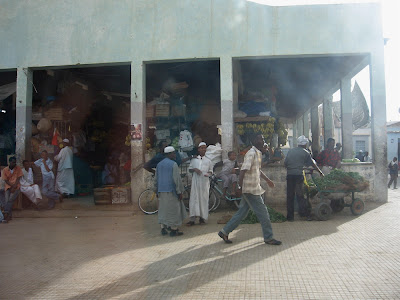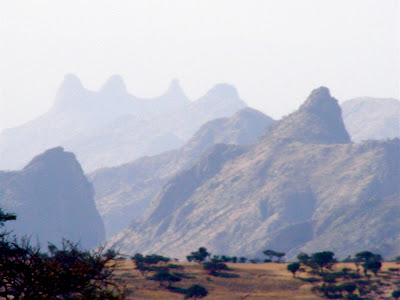 Beverages
Beverages
At long last, I am finally sitting down to write about the wide world of Eritrean beverages. I'll try to limit this to those that are unique or at least somewhat interesting. The most logical place to begin would probably be with sewa, but since I don't actually have any pictures of sewa, I will begin by discussing Eritrean coffee ceremonies.
Coffee: Traditional Eritrean coffee is a huge production. Traditionally, women make the coffee. Other than the elderly, most people in Asmara only have traditional coffee on special occassions. However, according to my friend Genet, older retired people will make traditional coffee every morning. Traditional coffee is also most common in the villages were people do not have access to either cafes serving cappucinos and macchiatos or to instant coffee.
My friend Genet performed a coffee ceremony for James' parents when they were visiting from Berkeley. Most of the following pictures were taken during that coffee ceremony.
Coffee ceremonies require several specialized devices, including a small cabinet where everything is stored, a short stool, a jemina (the clay pot the coffee is made in), a small stove, charcoal, a mortar and pestal for grinding the coffee, a small pan for roasting, a hair ball (a filter for the jemina made either from plastic or horse hair), and little coffee cups.

From what I can tell, the first step in making Eritrean coffee is to roast the beans. You can find green coffee beans in any store or market here in Eritrea. The woman preparing the coffee then roasts the beans over a charcoal fire like this one.

Next, she would grind the coffee. Traditionally and still in the villages where they don't have electricity, the coffee in ground by hand. The coffee is ground with a mortar and pestal, but I think they vary somewhat from those we use in the states to grind spices. Of course, Genet used an electric coffee grinder to grind ours.
The next step is to put the coffee in the jemina. The jemina should actually already have hot water in it.

Once the coffee is in, you put the jemina back on the stove. The cooking process is fairly lengthy. What Genet did was heat the coffee until it started boiling, then she removed it from the heat and cooled it down, and then put it back on the stove. She did this several times before the coffee was ready, each time checking the color of the coffee in the little tin cup.

Here is a picture of Anna pouring coffee in Tesseney. In Tesseney, they make their traditional coffee with ginger. It is really amazing stuff. The ginger makes the coffee spicy, and in a strange way, it reminds me of the Mexican hot chocolate with the chilis in it. Also, Eritreans like to put a lot of sugar in their coffee, and while the sugar can some times over power regular coffee, it can't overpower the ginger in the coffee from Tesseney.
 Sewa:
Sewa: Before I came to Eritrea, I read a book called
Ciao Asmara. The author, Justin Hill, referred to Sewa throughout this book as "sewer." And I think that's pretty apt. Sewa is one of those things that Eritreans really like than foreigners will never like. Sure, they will all tell you that you should try their grandmother's sewa or their best friend's aunt's sewa or warm sewa or cold sewa or sewa that is fresh or sewa that is a few days old and that if you just tried this one other kind of sewa, you would like it. But the fact is, you won't. It is just one of those things that foreigners just aren't going to understand, and that's fine. Fortunately, Eritreans often make mes when they make sewa, so I can usually decline the sewa without insulting anyone because I am still having a traditional drink.
Now, I realized, I know very little about sewa. What I do know if that it is an alcoholic beverage (although there is actually a Muslim version that is non-alcoholic) that is made from some sort of fermented bread. As a result, when sewa is fresh, it has chunky things floating in it. Since I don't know how you make sewa, I was hoping to find a website explaining it that I could provide a link to. Unfortunately, I haven't found anything like that.
Mes: Mes is a traditional alcoholic beverage made from honey. If you order it at an Ethiopian or Eritrean restaurant in the states, I believe they call it honey wine. However, mes really isn't wine. First, it is thicker than wine. It isn't thick, but it does have some consistency to it. Also, it doesn't really resemble wine in any other way. It's pretty tasty stuff though. Traditionally, it is served in glass bottles with a bottom that looks something like a smashed ball with a very long neck . That is a horrible explanation, but unforunately I don't have a photo. Also, according to the "mes place" (it's someone's house where they serve mes, so it doesn't seem to have a name), mes is made with red honey. My friend Genet says that honey comes in three colors--red, yellow, and white. I had no idea there was more than one color of honey.
Asmara Beer: What do you think? Do my friends and I drink enough beer?

There is one Eritrean beer brewer and that is the Asmara Beer Factory. From what I have gathered, the Asmara Beer company was previously the Melotti Beer Company, which was owned by an Italian family and was making beer in this country up until the late 90s. Asmara Beer is pretty cheap stuff--about 70 cents a bottle--but it's still a lot better than cheap beer in the US. I mean, I would drink Asmara Beer long before Coors or Budweiser.
Asmara beer bottle have one label on the front. I recently learned that they are actually supposed to have a back label as well, but the mechanical arm at the Asmara Beer Factory that is supposed to apply that label is broken, so the label doesn't go on. I don't know how long the arm has been broken, but what I can tell you is that I have never, in the six months I've been here, seen a beer bottle with two labels.
Zibib: Zibib is the brand name of a traditional Eritrean anis liquor. Zibib is really nasty stuff. It is so strong that literally a month after drinking Zibib out of some plastic cups we have in my house here in Asmara, you could still smell the Zibib. And this was after several washings. But Zibib is pretty popular here. People even put Zibib in tea. It has a special name, but I don't remember what it is. I should probably learn though so no one tricks me into drinking some.
Labels: Eritrea
 The UNMEE Line
The UNMEE Line





















